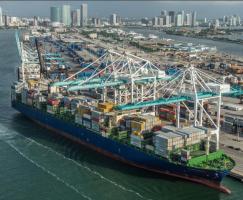 As if the waters off North Carolina’s Outer Banks aren’t dangerous enough, this morning the US Coast Guard released an announcement that “70 stray cargo containers pose a threat to mariners off North Carolina.”
As if the waters off North Carolina’s Outer Banks aren’t dangerous enough, this morning the US Coast Guard released an announcement that “70 stray cargo containers pose a threat to mariners off North Carolina.”
The Maersk Shanghai lost approximately 70 to 73 cargo containers due to high winds and heavy seas on Saturday. The over 10,000 TEU ship was the largest container ship to ever call on a Florida deep-water port on its first port call to South Florida, this summer.
The problem with shipping containers is that some do not sink, but can float mostly submerged for an extended period of time. They can be a real threat to small or moderate-sized vessels. There is solid evidence that the Irish sail-training ship Asgard II sank after hitting a floating container in 2010. Last year, Thomas Ruyant sailing in the Vendee Globe race, had his boat almost torn in half in a collision with what was believed to be a shipping container.
Estimates of how many containers go overboard vary widely. Estimates from the World Shipping Council (WSC) are based on reporting from shipping companies representing 80% of world container ship capacity. Of course, of the more than 100 million containers transported across the globe by ships, relatively few go over the side. Nevertheless, as volume increases the general trend in lost containers has been rising.
What makes the figures hard to analyze is what the WSC refers to as “catastrophic losses.” They define a catastrophic loss as any loss over 50 containers. Catastrophic incidents such as the loss of almost 4,300 containers in 2012 when the MOL Comfort broke apart in the Indian Ocean, or the 900 containers lost from the MV Rena in 2010, as well as the 520 containers lost from the Svendborg Maersk in 2014, the 391 containers lost on El Faro in 2015, or the 200 container lost from the MV Chitra in 2010, all tend to skew the average loss figures.
On the other hand, while the WSC refers to catastrophic losses as “rare,” they do tend to dominate the figures. Between 2010 and 2016, catastrophic losses equaled or exceeded other losses for every year except 2014. Given that the catastrophic losses dominated the losses for the last five out of six years, the terms “rare” should perhaps be reconsidered. The containers lost yesterday on the Maersk Shanghai would by WSC definition also be considered catastrophic.
So, how great a risk are floating shipping containers to mariners? Statistically, the chance of hitting a container at sea are very small. That being said, containers tend to float just above the surface and can do major damage to sailboat or fishing vessel. The odds of not hitting a container are definitely on your side, but sadly all it takes is one.

Maybe shipping containers need to have an explosive that can be activated to sink when the container is in the water after a specified amount of time?
Maybe when one hits the water, an antenna pops up to send a warning signal.
I had exactly the same worry about how many containers were lurking unseen just below the surface and did probably the same google search as you. I’m just glad that my sturdy old Nic32 can only bob along at six knots max unlike modern stuff which arrives at the scene of the sinking much quicker.